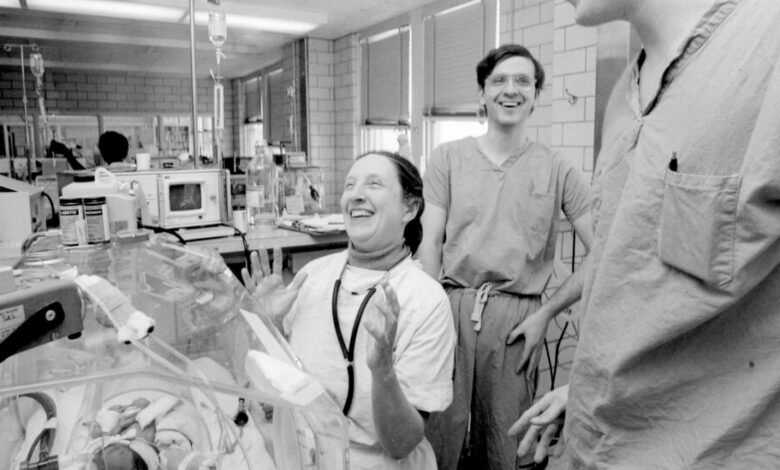Mildred Thornton Stahlman, pioneer in neonatal care, dies at age 101

Dr. Mildred Thornton Stahlman, a Vanderbilt University pediatrician whose research into deadly lung diseases in newborns led to lifesaving treatments and the creation in 1961 of one of the first neonatal intensive care units, died Saturday at her home in Brentwood, Tennessee. She was 101.
Her death was confirmed by Eva Hill, the wife of Dr. Stahlman’s nephew George Hill.
On October 31, 1961, Dr. Stahlman placed a gasping premature baby into a miniature iron lung machine, also known as a negative pressure ventilator, the kind used for children with polio. The machine worked by stretching the baby’s weak chest muscles to draw in air. The baby survived.
That initial success, along with findings from Dr. Stahlman’s studies of newborn lambs, helped usher in a new era in the treatment of respiratory lung disease, a leading cause of death among premature babies. Immature lungs lack surfactant, a soapy chemical that coats the air sacs. Without surfactant, the tiny sacs collapse.
Shortly after her first success, Dr. Stahlman reported that in 1965 she had used the iron lung machine to save 11 of the 26 babies at Vanderbilt. In the 1970s, suppression tanks were jettisoned in favor of positive-pressure machines that worked by inflating the lungs. In the 1990s, the use of surfactants from animal lungs dramatically improved the survival of babies with serious illnesses who required mechanical ventilation.
“Milly was one of the first to carefully and scientifically push the boundaries of viability in premature babies,” said Dr. Linda Mayes, a Yale professor of child psychiatry, pediatrics and psychology and chairman of the Yale Child Study Center, trained under Dr. Stahlman. “She was a physician-scientist long before that expression became popular.”
In the early days of neonatology, Dr. Stahlman was one of the few doctors in the world who knew how to place tiny catheters in the umbilical cord vessels of newborns to monitor blood oxygen, Sarah DiGregorio wrote in her book: “Early: An Intimate History of Premature Birth and What It Teaches Us About Being Human.” The procedure was critical to ensure the babies received enough oxygen to stay alive, but not so much that they went blind.
Dr. A small, fearsome woman with piercing blue eyes and a tight bun, Stahlman was known for her fierce devotion to her patients and her students. Many of her students remember the so-called Milly rounds, where they visited every newborn on the ward and were expected to know every detail, from accurate laboratory values to family life at home.
“Her severity was shocking to the predominantly male staff, especially a woman who stood just 5 feet 9 inches tall and weighed 100 pounds,” said Dr. Elizabeth Perkett, retired professor of pediatric pulmonology at Vanderbilt University and the University of New Mexico.
Dr. Stahlman’s research also included studying normal and abnormal lung physiology in newborn lambs. For a time, pregnant ewes grazed in a yard at Vanderbilt.
“She was struck by the fact that some of the babies who were nearly full-term, and not premature, had hyaline membrane disease,” the former name for respiratory distress syndrome, said Dr. Hakan Sundell, professor emeritus of pediatrics at Vanderbilt University and director of the animal lab.
In 1973, Dr. started. Stahlman launched an outreach program, training nurses in rural areas and overseeing the creation of a mobile health van that stabilized babies traveling from local hospitals to Vanderbilt. A former bread truck was converted with a ventilator, monitors and heat lamps. Within a year, newborn deaths dropped 24 percent, her team reported in the February 1979 issue of the Southern Medical Journal.
Dr. Stahlman also pioneered follow-up therapy for premature babies, monitoring them into toddlerhood to track psychological and physical development.
“She was a forerunner in research and innovation, and she also had foresight, understanding the ethical issues and the limits of technology,” said Dr. Pradeep N. Mally, chief of neonatology at NYU Langone Health and neonatologist at Hassenfeld Children’s Hospital at NYU Langone.
Mildred Thornton Stahlman was born on July 31, 1922 in Nashville, the son of Mildred Porter (Thornton) Stahlman and James Geddes Stahlman. publisher of The Nashville Banner.
Dr. Stahlman graduated from Vanderbilt University in 1943 and was one of three female students out of 47 who graduated from Vanderbilt University Medical School in 1946.
She spent a year as an intern at Lakeside Hospital in Cleveland, followed by a year as a pediatric intern at Boston Children’s Hospital, where she completed her pediatric residency at Vanderbilt. She first trained in pediatric cardiology at La Rabida Children’s Hospital in Chicago, and then spent a year at the Karolinska Institute in Sweden.
Dr. Stahlman returned to Vanderbilt in 1951 and became director of the Division of Neonatology in 1961, a position she held until 1989.
In addition to her laboratory and clinical work with premature infants, she also focused on the impact of poverty on disease, growing health care inequality, and the harmful effects of profit-oriented medical care models.
“Prematurity has become largely a social, not a medical, disease in the United States,” she wrote in 2005 in the magazine Journal of Perinatology. “The rapid rise of for-profit hospitals, where the interests of shareholders dominated the interests of our patients, was followed by for-profit neonatology, and that has been profitable.”
Dr. Stahlman was a member of the Institute of Medicine from 1984 to 1985 and president of the American Pediatric Society. Among her many awards, she received the Virginia Apgar Award from the American Academy of Pediatrics and the John Howland Medal from the American Pediatrics Society.
She had no immediate survivors.
Today, Martha Lott, the first baby Dr. Stahlman fitted into the iron lung machine, is a nurse at the scene where her life was saved. “I knew the story and was tested for years,” Mrs. Lott said. Dr. Stahlman was her godmother, she said.
“I think they assumed I was going to have problems,” related to the daring treatment. She didn’t do it. “It’s amazing,” she added, “how much technology has changed in the last sixty years.”




